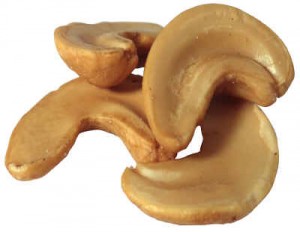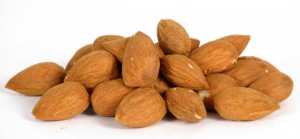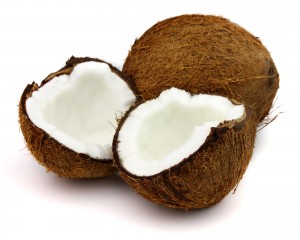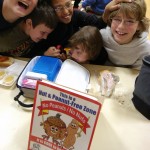The tree nut includes nuts such as cashews, almonds, pecans and walnuts among others. The peanut is actually a legume. However, some children do have an allergy to both peanuts and tree nuts. There is a 30 to 60% chance of a child with a peanut allergy to develop a tree nut allergy according to research by Scott H. Sicherer, M.D., associate professor of pediatrics at the Mount Sinai School of Medicine in New York City and a researcher in the Jaffe Food Allergy Institute. Your child will need to be tested in order to determine the exact nature of their allergy.
Check out “Chad the Allergic Chipmunk: A Children’s Story of Nut Allergies”, a children’s book that tells a heartwarming story of a young chipmunk learning to live with nut allergies. “Chad” helps children learn about nut allergies and how to recognize an allergic reaction. Find out more information here.
 The cashew is in the cashew botanical family along with mango and pistachio. Interestingly, I had a terrible case of poison ivy when I was pregnant with my son. In his toddler years, we found out about his allergy to cashews! Coincidence? I don’t know!
The cashew is in the cashew botanical family along with mango and pistachio. Interestingly, I had a terrible case of poison ivy when I was pregnant with my son. In his toddler years, we found out about his allergy to cashews! Coincidence? I don’t know!
An almond is actually in the plum family along with apricot, cherry, nectarine, peach, plum and the prune plum, yet it is considered a tree nut by  most allergists. It is definitely possible to be allergic to almond, yet be able to tolerate peaches or the other foods in the botanical family. My son fits into this category. It’s also possible to be allergic to all of these foods. Only an allergy testing interpreted by a Board Certified Allergist can determine all of this however!
most allergists. It is definitely possible to be allergic to almond, yet be able to tolerate peaches or the other foods in the botanical family. My son fits into this category. It’s also possible to be allergic to all of these foods. Only an allergy testing interpreted by a Board Certified Allergist can determine all of this however!
 The pecan is in the walnut botanical family along with the butternut, hickory nut and black and English walnut.
The pecan is in the walnut botanical family along with the butternut, hickory nut and black and English walnut.
Many people wonder if coconut, nutmeg, water chestnuts and shea nuts are nuts. The coconut is in the palm family, and while it is possible to be  allergic to coconut…it doesn’t cross react with tree nuts. Our son tolerates coconut without a problem. Yet coconut has been determined to be a tree nut by the FDA for purposes of labeling – very confusing! Food that includes coconut will likely have a label stating that the product includes Tree Nuts.
allergic to coconut…it doesn’t cross react with tree nuts. Our son tolerates coconut without a problem. Yet coconut has been determined to be a tree nut by the FDA for purposes of labeling – very confusing! Food that includes coconut will likely have a label stating that the product includes Tree Nuts.
Nutmeg and water chestnuts are not considered nuts either, and there’s no need to stay away from them if you have a nut allergy, according to our allergist. I have heard of children being allergic to them, so in the allergy world, anything is possible. The nuts of Shea tree yield a vegetable fat known as shea butter. The trees grow in Africa and provide income for women in the region who pound the nuts. They would be considered a nut, and we stay away from them.
When my son, Morgan, was diagnosed with a severe peanut allergy at 18 months old, our allergist suggested that we keep him away from all tree nuts and shellfish. She said that many children do have reactions to all of these foods. We waited for another two years after the initial peanut allergy diagnoses before redoing an allergy skin prick test. The second allergy test included a retest for the peanut allergy, along with a test of each tree nut separately. Morgan tested a 4+ on cashews, and had no allergy to pecans. We decided that with the possibility of cross-contamination, we would opt for no nuts in Morgan’s diet. To read more about Morgan’s journey with food allergies, please click here.
Yet some allergists will suggest that if your child is not allergic to pecans, for example, that it would be safe to eat these in their raw form only. The chance that one nut could be substituted for another nut in the manufacturing process makes eating nuts in this fashion more risky. Eating a safe nut in its raw state would have less chance of cross contamination. We still aren’t willing to assume this risk, and therefore have removed all nuts from our son’s diet.
We used posters throughout our son, Morgan’s, elementary school years. The “No Peanuts & No Nuts” firey man poster was great for his Middle School years. Here he is with a group of friends in 5th grade enjoying the “Nut Free Zone” in his school lunch cafeteria. While we no longer offer these posters for sale, you can find many others with a Google image search online.

Read all labels to ensure no consumption of Tree nuts!
The only “cure” currently for the tree nut allergy is to stay away from all nuts and nut products. Read labels of all the foods that your child eats, and all foods in your house. Read labels each time you purchase a product because manufacturing processes change frequently.
Need help reading labels for tree nut allergies? Click here
The Food Allergy Labeling Consumer Protection Act (FALCPA) was passed in 2004, requiring: labels to be marked such that a 7 year old could read and understand the ingredients, all allergens are declared even if they are in the spices or flavorings, and curtail the current widespread use of the ‘may contain statements.’ This act went into effect January 1, 2006.
It is safest to avoid all kinds of nuts even if your child is allergic to just one. The processing of nuts in foods lends itself to cross-contamination easily and isn’t worth the risk.
Stay away from all your ‘standard’ tree nuts, which include almonds, cashews, pecans, and walnuts.
Any product that says ‘nuts’ must be avoided. These would include macadamia nuts to name just one. There are many kinds of nuts, so read labels carefully. Remember pistachios are a nut!
In 2006, the FDA classified coconut as a nut. If coconut is in a product, the product may state that it contains tree nuts. This is confusing, especially if your child can tolerate coconut but not other tree nuts!
Sometimes cashews are used to make butter (cashew butter), oils or pastes. Stay away from all of these.
Pesto sauce usually includes pine nuts – be careful of homemade recipes where nuts can be used and yet not recognized in sauces, etc.
Your allergist should be able to provide you with a complete listing of ingredients that may indicate nut protein. There are always new products being created with newly processed ingredient names. If you don’t know the exact nature of the ingredient, don’t eat it!
Tree nuts can show up in products that aren’t ingested, but used in lotions and shampoos. Read the labels on these products also. Contact allergies can cause severe reactions also.


I take not allergies seriously, but I find that many people and schools go too far with it.
When I lived in Canada I babysat a little girl on a regular basis and made sure she got her meals planned and made it to the bus stop. With her parents permission I once sent her to school with an almond butter and jelly sandwich because it was a nut free school and the school responded by confiscating the sandwhich and sending her home with an angry letter. I explained to the school almonds are not tree nuts. They are the pit of a fruit. The school wouldn’t budge on the issue.
In the end she wasn’t allowed to have a nutritious lunch – instead being given thin Bologna by the school – all because people over react to scare and apply it to everything that even resembles a nut. That’s the point that I draw the line. While I can certainly believe that someone could be allergic to almond, it wouldn’t be the result of a nut allergy and if you banned every food that someone might be allergic to somewhere on the off chance that it might hurt someone, well, that doesn’t leave anything left to eat.
In the case of peanuts I completely understand. The dust alone circulating can cause nearby children to be injured, but I can’t find any evidence of anyone with a nut allergy responding like that to being around almonds. Again, anyone can be allergic to anything, but you have to draw the line somewhere, don’t you? Or can you provide me evidence that an almond allergy is as serious as a peanut allergy? And if so why not ban peaches and cherries with it?
You call and almond butter and jelly sandwich nutritious? LOL
Yes, although it depends on the type you use. If you grind it yourself without adding salt and if the “jelly” is a Preserves it’s VERY healthy. It’s a very good balance of natural sugars and protein, and if you put it on a whole grain bread it’s very filling.
http://nutritiondata.self.com/facts/nut-and-seed-products/3153/2
It’s not the most nutritious lunch in the world, but it’s definitely a better lunch for a 5 year old girl than what the school gave her.
So you ground the almonds to make the almond butter and made homemade preserves with no sugar added???? The link for almond butter you posted above with the protein content of 38g is for an entire CUP of almond butter. I’m going to guess that this almond butter and preserves sandwich didn’t quite have that much almond butter. The tablespoon or so of AB that was on there contains 2g of protein (I found that by changing the serving size in your link above), whereas the “serving” of bologna has 3g. The only reason I’m mocking you is because you said that an almond butter and jelly sandwich was healthy.
You don’t need to add salt or sugar to the almonds in a grinding machine. The natural sugars of the preserves takes care of that.
Right, slight oversight, but at 2.4 grams per tablespoon it’s still more than in bologna since there would be more than a few tablespoons on a given sandwich. There’s still the fact that almond butter has a wide range of other nutrients.
Yes, an almond butter and jelly sandwich is nutritious, based on the criteria that nutritious is nourishing and contains what the child needs to grow up healthy. A single meal doesn’t have to contain all the nutrients she needs, but should contain what she needs for proper growth, concentration, blood sugar levels, etc.
Next time you mock someone you should take out a dictionary:
nu·tri·tious
adjective
nourishing; efficient as food.
I am allergic to cashews and dairy, and cashews are how they make vegan dairy products. It really stinks to not be able to have dairy NOR the dairy substitute.
Why not have almond, coconut or hemp products?
Cheryl, there are other types of vegan milk available. The ones I’m aware of are Soy, Hemp, Almond, Hazelnut, Oat, Rice and Coconut, but there may be more that I’m not aware of. Obviously a lot of those are nuts but perhaps the Oat milk or Rice milk? I’ve been a vegetarian most of my life and I’m slowly trying to become vegan now – so far I’ve only had the regular soy milk and the almond milk (both made by Alpro – I’m in the UK, so don’t know if they sell worldwide or are a UK only company?) but I know they make other types too. Might be worth googling it and seeing what company makes it wherever you live? Hope you can find an alternative you can have! 🙂
I have created a food allergy app which includes tree nut allergy.
You can check it out at :
https://play.google.com/store/apps/details?id=com.foodaversions.people